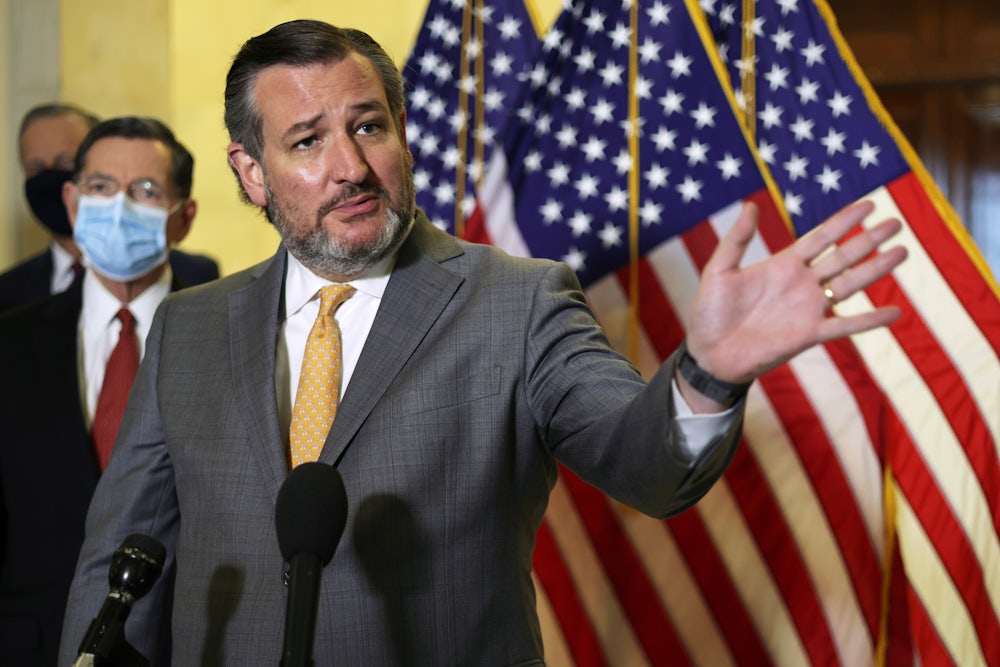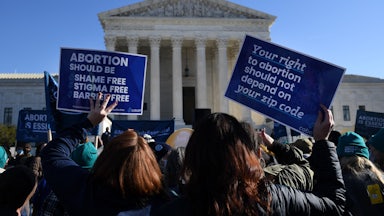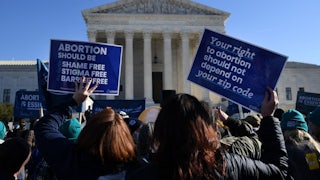Wednesday’s oral arguments in Dobbs v. Jackson Women’s Health Center produced a flurry of commentary on what looks like the imminent demise of Roe v. Wade. Almost every mainstream court-watcher saw no path to five votes that would strike down Mississippi’s 15-week abortion ban; others, myself included, saw at least five votes to overturn Roe outright. But a notable minority of observers on the right apparently saw something else.
Fox News host Laura Ingraham opened her broadcast on Wednesday night by playing a clip of New Hampshire Senator Jeanne Shaheen, who predicted a “revolution” on Monday if the court overturns Roe. “We hope the Supreme Court is listening to us tonight, not to her,” Ingraham said. “Why? Because if a 6–3 conservative Supreme Court isn’t enough to overturn Roe, then the entire conservative legal movement will have been in vain.” Ingraham is not just another Fox News host. Before her career in broadcasting, she was a Harvard Law graduate and a clerk for Justice Clarence Thomas. So when she talks about the conservative legal movement, she speaks with some experience.
“Senator, if we have six Republican appointees on this court, after all the money that has been raised, the Federalist Society and all these fat-cat dinners, I’m sorry, I’m pissed about this,” she said, during an interview on Wednesday with Texas Senate Ted Cruz. “If this court with six justices cannot do the right thing here, the constitutional thing, then I think it’s time to do what Robert Bork said we should do, which is to circumscribe the jurisdiction of this court. And they want to blow it up, then that is the way to change things finally. Because this can’t stand, this is insane.”
Ingraham was referring to jurisdiction stripping, in which Congress uses its constitutional power to bar the federal courts from considering certain issues. Cruz, her guest, readily supported the idea of ending the Supreme Court’s power to review abortion-related cases, which would allow states to restrict abortion without federal judicial scrutiny. “I would do that in a heartbeat,” he replied. “As you know, the Constitution gives Congress the authority to restrict the jurisdiction of the court, and I think we should do that.”
The exchange is a useful window into how the conservative judicial machine actually works—and sometimes doesn’t. Three generations of right-wing legal activists have spent their lives building a movement that would create a reliably conservative Supreme Court, all the while largely pretending that they weren’t actually doing this. They portrayed originalism and textualism as neutral tools for judicial decision-making while expecting that the judicial nominees they backed would largely rule in ways that advanced conservative policy priorities. And now some of them are terrified that all of it might still not have been enough.
This dynamic bubbled up to the surface most recently last June, when the Supreme Court ruled in Bostock v. Clayton County that gay and transgender workers are protected by Title VII’s ban on workplace discrimination. The 6–3 ruling was written by none other than Justice Neil Gorsuch, the deeply conservative jurist whom former President Donald Trump and Senate Republicans chose to replace Antonin Scalia in 2017. (Chief Justice John Roberts also joined the majority, but he was already viewed as a semi-apostate by many right-wing legal activists.) Gorsuch grounded his ruling in the textualist reading of statutes that legal conservatives had long championed, even though it led to an outcome favored by liberals.
The ruling in Bostock—and especially Gorsuch’s central role in it—sparked outrage throughout the conservative legal movement. In dissent, Justice Samuel Alito denounced Gorsuch’s majority opinion as a “pirate ship [that] sails under a textualist flag” and suggested that Scalia would not have supported it. Conservative legal activists who work for groups that spent millions to put Gorsuch on the court treated his ruling as a palpable betrayal. Missouri Senator John Hawley took to the Senate floor to declare an end to the conservative legal movement itself.
“This decision, and the majority who wrote it, represents the end of something,” he said in a Senate speech. “It represents the end of the conservative legal movement, or the conservative legal project, as we know it. After Bostock, that effort, as it has existed up to now, is over. I say this because if textualism and originalism give you this decision, if you can invoke textualism and originalism in order to reach such a decision—an outcome that fundamentally changes the scope and meaning and application of statutory law—then textualism and originalism and all of those phrases don’t mean much at all.”
There are those in the conservative legal movement who genuinely think that originalism and textualism are the most reliable and most value-neutral way to interpret the Constitution and read federal statutes. But there are a healthy number of right-wing activists who largely saw these legal theories as a means to an end, whether that end be the demise of legalized abortion, a dramatic scaling back of federal regulatory power, a judicial reification of social-conservative views on sexuality and gender, and more.
In one sense, I can’t blame them for their trepidation. Creating a reliably conservative Supreme Court was a multidecade, multibillion-dollar effort. Wealthy right-wing donors filled the coffers of conservative think tanks, endowed professorships at major universities for originalist legal scholars, and built right-wing super PACs who could bolster right-wing candidates. Rank-and-file activists turned out voters for presidential candidates who could nominate conservative judges and senators who could confirm them. Nobody puts that much time and money into something without expecting a little return on investment.
But from the right’s perspective, it hasn’t actually really achieved anything yet. It looks at the Roberts court’s track record and sees a mixture of partial, rearguard victories in some cases, interspersed with crushing generational defeats on the Affordable Care Act and LGBT rights. “Why can’t I fire gay and transgender folks or deny them services just because of who they are?” they might ask. “Why are abortion clinics still open in my red state? Why is the EPA still telling my coal-burning power plant to reduce emissions? Why does Obamacare still exist? Why can’t all those death-row prisoners just die already? Why hasn’t all our hard work paid off yet?”
This sense of doom and gloom is bewildering to liberals, to say the least. Republicans just spent the last four years replacing a third of the Supreme Court with fiftysomethings who could still be deciding cases into the 2060s. The GOP stacked the lower federal courts with enough conservative jurists to make life a miserable slog for Democratic presidents and Congresses for the foreseeable future. And Roberts and his fellow conservatives happily disemboweled the Voting Rights Act of 1965, set fire to bipartisan campaign-finance reform, and greenlit voter-suppression campaigns and extreme partisan gerrymandering throughout the states, making it increasingly possible that the GOP can govern without any real electoral mandate.
But the reality-defying sense of imminent defeat is palpably real for those who’ve struggled to build a reliably conservative Supreme Court over the last three or four decades—a Supreme Court that isn’t just not-liberal but that is aggressively pursuing conservative policy goals. As I explained during Kavanaugh’s confirmation hearing, those activists spent the 1980s and 1990s on this project only to see it frustrated by moderates like Sandra Day O’Connor and Anthony Kennedy and betrayed (at least in their eyes) by apostates like David Souter. They thought Roe’s demise was in their grasp in the early 1990s, only to see those three justices rewrite and reaffirm it in Planned Parenthood v. Casey.
So deeply rooted are these right-wing fears that their hand-picked justices still aren’t conservative enough—that they’ll turn into more Souters—that Cruz only saw two votes to overturn Roe where most others saw four or five. “It is something sad, looking at this court, as you were going through counting noses; there are only two justices I am confident how they are going to vote on overruling Roe: That is Justice Thomas and Justice Alito,” Cruz said. “I’m hopeful we get to five, but I’m not at all certain.”
It’s worth pausing to take in just how bewildering that statement is. Cruz is no stranger to the Supreme Court or the justices themselves: He clerked for then–Chief Justice William Rehnquist in the 1990s, argued cases before the court as Texas’s solicitor general in the 2000s, and now holds a seat on the Senate Judiciary Committee. And he thinks there are just two votes for overturning Roe on the high court right now? Justice Amy Coney Barrett, whom he voted to confirm just over one year ago, literally belonged to anti-abortion advocacy groups before joining the bench. Barrett, along with Justices Neil Gorsuch and Brett Kavanaugh, even voted to let Texas’s extreme anti-abortion bounty law go into effect.
Sure, some of this from Ingraham and Cruz might just be anxious posturing. But it also speaks to the deeper fact that when many Republicans talked about wanting judges who would simply read the law and interpret the Constitution as written, they actually meant that they wanted judges who would do what they desired without regard for the institutions that uphold it. Conservatives have a clear agenda at the Supreme Court, after all, and they expect that the six Supreme Court justices they worked so hard to install will simply obey.










